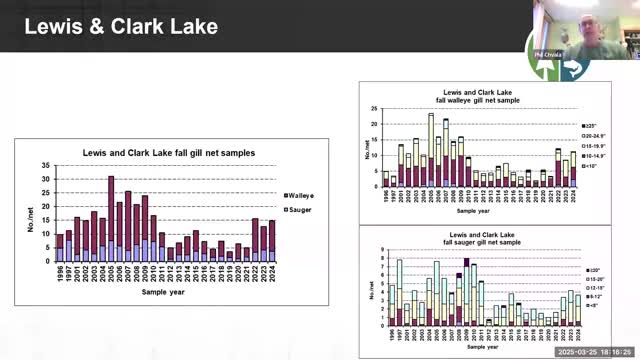Research project reveals fish population recovery at Lewis And Clark Lake
May 23, 2025 | Nebraska Game and Parks Commission (NGPC), State Agencies, Organizations, Executive, Nebraska
This article was created by AI summarizing key points discussed. AI makes mistakes, so for full details and context, please refer to the video of the full meeting. Please report any errors so we can fix them. Report an error »

In a gathering marked by a sense of optimism, the Nebraska Northeast District Fisheries Meeting on May 23, 2025, showcased significant developments in the management of Lewis and Clark Lake's fishery. Attendees were greeted with a presentation that highlighted a remarkable recovery in fish populations over the past three years, following a challenging period that began in 2011. The combined catch rate in 2024 reached approximately 15 fish per net, with 41% of those measuring 15 inches or longer, indicating a healthy population available for harvest.
The meeting delved into the intricate relationship between water flow and fish populations, particularly walleye and sauger. Graphs presented illustrated that maintaining lower flow rates is crucial for sustaining fish catch rates. A critical threshold was identified at 25,000 cubic feet per second (CFS); exceeding this flow significantly impacts catch rates. The data emphasized the need for consecutive low flow years to support fish populations, a situation currently being observed.
Research conducted by Will Radagon from the University of Nebraska-Lincoln further enriched the discussion. His study focused on larval entrainment and adult fish movement between Fort Randall and Gavin's Point Dams. The findings revealed that Lewis and Clark Lake operates as a "losing system," with a concerning ratio of fish lost to those gained during high flow periods. In 2021, for instance, the lake lost eight fish for every one gained, underscoring the vulnerability of the fishery to flow dynamics.
The presentation also detailed the movement patterns of tagged walleye and sauger, revealing diverse behaviors among individuals. Some fish exhibited a "homebody" lifestyle, remaining in a limited area, while others traveled significant distances, particularly during spawning seasons. This variability in movement patterns is crucial for understanding the dynamics of the fishery and informing future management strategies.
As the meeting concluded, participants left with a renewed sense of hope for the future of Nebraska's fisheries. The insights gained from the data and research presented will play a vital role in shaping sustainable practices that ensure the health of fish populations in Lewis and Clark Lake for years to come. The ongoing commitment to monitoring and research promises to safeguard this vital resource, fostering a thriving environment for both fish and anglers alike.
The meeting delved into the intricate relationship between water flow and fish populations, particularly walleye and sauger. Graphs presented illustrated that maintaining lower flow rates is crucial for sustaining fish catch rates. A critical threshold was identified at 25,000 cubic feet per second (CFS); exceeding this flow significantly impacts catch rates. The data emphasized the need for consecutive low flow years to support fish populations, a situation currently being observed.
Research conducted by Will Radagon from the University of Nebraska-Lincoln further enriched the discussion. His study focused on larval entrainment and adult fish movement between Fort Randall and Gavin's Point Dams. The findings revealed that Lewis and Clark Lake operates as a "losing system," with a concerning ratio of fish lost to those gained during high flow periods. In 2021, for instance, the lake lost eight fish for every one gained, underscoring the vulnerability of the fishery to flow dynamics.
The presentation also detailed the movement patterns of tagged walleye and sauger, revealing diverse behaviors among individuals. Some fish exhibited a "homebody" lifestyle, remaining in a limited area, while others traveled significant distances, particularly during spawning seasons. This variability in movement patterns is crucial for understanding the dynamics of the fishery and informing future management strategies.
As the meeting concluded, participants left with a renewed sense of hope for the future of Nebraska's fisheries. The insights gained from the data and research presented will play a vital role in shaping sustainable practices that ensure the health of fish populations in Lewis and Clark Lake for years to come. The ongoing commitment to monitoring and research promises to safeguard this vital resource, fostering a thriving environment for both fish and anglers alike.
View full meeting
This article is based on a recent meeting—watch the full video and explore the complete transcript for deeper insights into the discussion.
View full meeting
